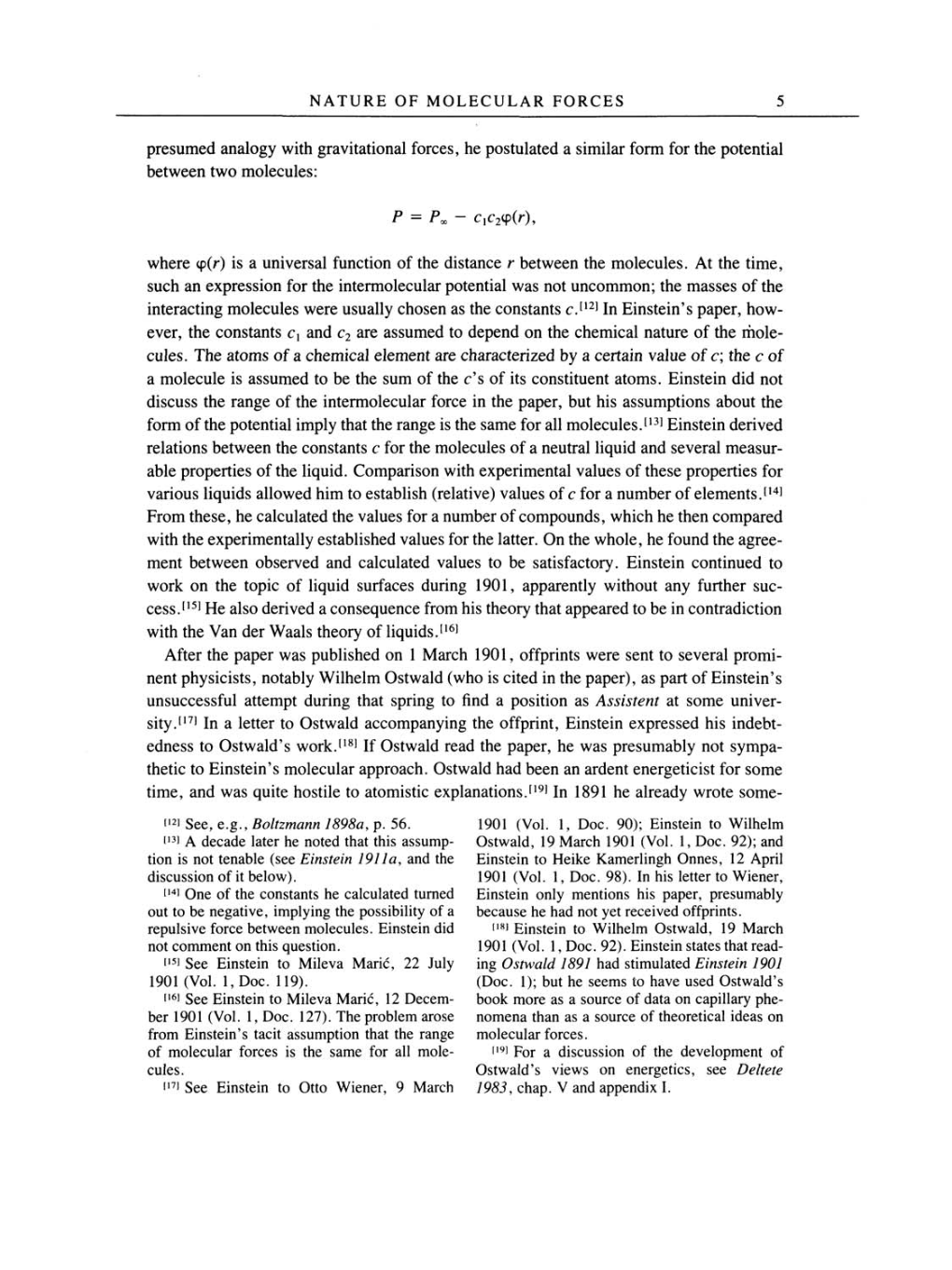NATURE OF
MOLECULAR FORCES
5
presumed
analogy
with
gravitational
forces,
he
postulated a
similar form for the
potential
between two molecules:
P
=
P*-
C1C2p(r),
where
p(r)
is
a
universal function
of
the distance
r
between the molecules. At the
time,
such
an expression
for the intermolecular
potential was
not uncommon;
the
masses
of
the
interacting
molecules
were usually
chosen
as
the constants
c.[12]
In
Einstein's
paper,
how-
ever,
the constants
c1
and
c2
are
assumed to
depend on
the chemical nature
of
the
mole-
cules. The atoms
of
a
chemical element
are
characterized
by
a
certain value
of
c;
the
c
of
a
molecule is assumed to
be the
sum
of
the
c's of
its constituent atoms.
Einstein did
not
discuss the
range
of
the intermolecular
force in the
paper,
but
his
assumptions
about the
form
of
the
potential imply
that the
range
is
the
same
for all molecules.[13] Einstein derived
relations between the constants
c
for the molecules
of
a
neutral
liquid
and several
measur-
able
properties
of
the
liquid. Comparison
with
experimental
values
of
these
properties
for
various
liquids
allowed him to establish
(relative)
values
of
c
for
a
number
of
elements.[14]
From these,
he
calculated the
values for
a
number
of
compounds,
which he then
compared
with the
experimentally
established values for the latter. On the
whole,
he found the
agree-
ment between observed and calculated values to be
satisfactory.
Einstein continued to
work
on
the
topic
of
liquid
surfaces
during
1901,
apparently
without
any
further
suc-
cess.[15]
He also derived
a consequence
from his
theory
that
appeared
to be
in
contradiction
with the Van der Waals
theory
of
liquids.[16]
After the
paper was published on
1
March
1901,
offprints were
sent to several
promi-
nent
physicists,
notably
Wilhelm Ostwald
(who
is
cited
in
the
paper), as part
of Einstein's
unsuccessful
attempt during
that
spring
to
find
a
position as
Assistent
at
some
univer-
sity.[17]
In
a
letter
to
Ostwald
accompanying
the
offprint,
Einstein
expressed
his indebt-
edness to
Ostwald's
work.[18]
If
Ostwald read the
paper,
he
was presumably
not
sympa-
thetic to
Einstein's
molecular
approach.
Ostwald
had
been
an
ardent
energeticist
for
some
time,
and
was quite
hostile to atomistic
explanations.[19]
In
1891
he
already
wrote
some-
[12] See, e.g.,
Boltzmann 1898a,
p.
56.
[13] A
decade later he noted that this
assump-
tion
is not
tenable
(see
Einstein
1911a,
and the
discussion
of
it
below).
[14]
One
of
the
constants
he calculated turned
out to
be
negative, implying
the
possibility
of
a
repulsive
force between molecules. Einstein did
not
comment
on
this
question.
[15]
See Einstein to Mileva
Maric,
22
July
1901 (Vol.
1,
Doc.
119).
[16]
See Einstein
to
Mileva
Maric, 12
Decem-
ber
1901 (Vol.
1,
Doc.
127).
The
problem arose
from
Einstein's
tacit
assumption
that the
range
of
molecular forces
is
the
same
for all mole-
cules.
[17]
See Einstein to Otto
Wiener, 9
March
1901 (Vol.
1,
Doc.
90);
Einstein to Wilhelm
Ostwald,
19
March
1901 (Vol.
1,
Doc. 92); and
Einstein
to
Heike
Kamerlingh Onnes,
12
April
1901 (Vol.
1,
Doc.
98).
In his letter
to Wiener,
Einstein
only
mentions
his
paper, presumably
because he had
not
yet
received
offprints.
[18]
Einstein
to
Wilhelm
Ostwald, 19
March
1901 (Vol.
1,
Doc.
92).
Einstein
states
that read-
ing
Ostwald
1891 had stimulated Einstein 1901
(Doc.
1);
but he
seems
to
have used
Ostwald's
book
more as a source
of
data
on capillary phe-
nomena
than
as a source
of
theoretical ideas
on
molecular
forces.
[19]
For
a
discussion
of
the
development
of
Ostwald's
views
on energetics, see
Deltete
1983,
chap.
V
and
appendix
I.
